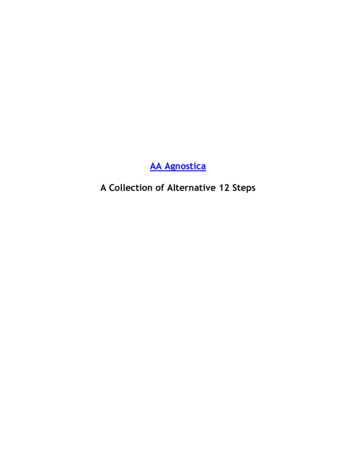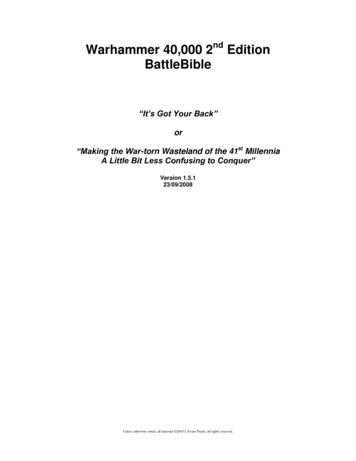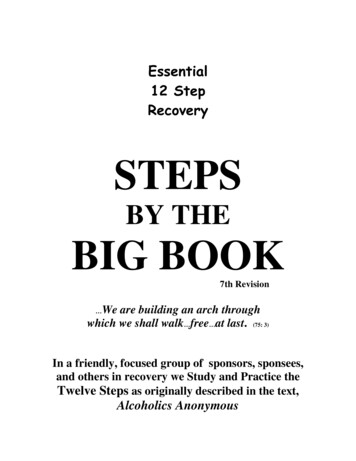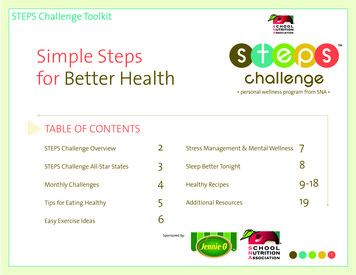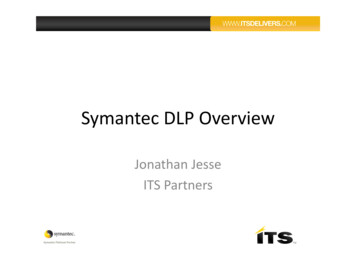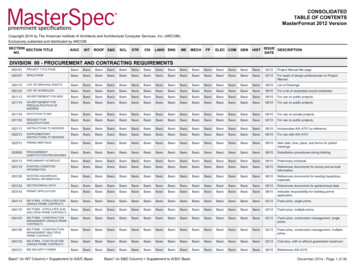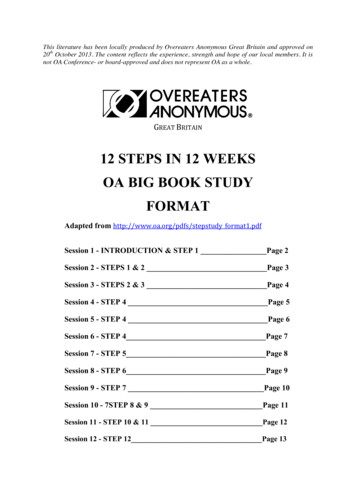
Transcription
Basic Steps To Protect Your Intellectual Property in ThailandThe European ASEAN Business Centre in Thailand (EABC)25th Floor, Empire Tower, 195 South Sathorn Road, Yannawa, Sathorn, Bangkok 10120Tel: 66 2670 0624 Fax: 66 0670 0608 Email: office@eabc-thailand.eu www.eabc-thailand.euCopyright EABC 2013. All rights reserved.Published by The European ASEAN Business Centre in Thailand (EABC)ISBN: 978-616-91558-3-6DisclaimerThe material in this publication is designed to be used as a source of general reference and informationand is intended to provide transparent information and offer first instance guidance on intellectualproperty and trade-related issues in Thailand to those interested. The content is the sole responsibilityof the EABC and the authors. It is not to be considered legally binding, or in any way to replace anyregulatory documents or trade/investment issues and recommendations raised in the EABC EuropeanBusiness Position Paper in Thailand. Views expressed are those of the authors and do not necessarilyreflect those of the European Commission, nor other relevant authorities in Europe and Thailand.Content in this guidebook may be reproduced and disseminated, in whole or in part, for publicinformation only, provided that it is attributed to the original source. A copy of the republicationcontaining the quotation or citation from this guidebook is required to be sent to the EABC. Anyadaptation or translation of the information from this guidebook is required to have prior permissionfrom copyright holders. Should you be interested, please contact counsel@eabc-thailand.eu
About This GuideThis guide is intended for business owners, executives, and intellectual property (IP) enthusiasts.The guide provides information about intellectual property (IP) in Thailand and offers strategies forprotecting and maximizing IP assets. Also included in this guide are recommended business practicesand procedures to help protect such IP assets from counterfeiting and piracy.This guide is divided into three sections.The first section provides a general overview of practical business tips for identifying IP assets andbuilding contractual protection of these assets.The second section explains and addresses protection of the following IP assets: trademarks, patents,copyrights, trade secrets, domain names, and geographical indications. Information about pertinentlaws, regulations, and suggested practices are also included in this section.The third section presents IP enforcement issues and information about available remedies in Thailandin cases of IP infringement. It includes information about enforcement agencies and strategies toeffectively combat IP violations.
About The European ASEAN Business Centre in Thailand (EABC)The European ASEAN Business Centre in Thailand (EABC) is a newly established platform representingthe interests of the European business community in Thailand. Our main objective is to contributeto the improvement of the trade and investment climate for European companies in Thailand and toincrease trade, investment and the establishment of European companies and businesses in Thailand.Through its constructive engagement with the Thai authorities and counterparts, EABC strives towork towards achieving a greatly strengthened Thai economy with sustainable competitiveness. EABCsupports trade advocacy by playing an important role as an independent voice of European businessvis-à-vis Thai authorities. It also acts as a focal point for market information for European companiesboth in Thailand and Europe, facilitating their market access.Who we areEABC was established as a consortium with sixteen business organisations and chambers of commerce,both in Thailand and Europe1,2with a combined membership base of EABC and our Consortiumpartners of approximately 2,000 companies in Thailand. EABC is part of a strategy of the EuropeanUnion to support the internationalisation of European SMEs and other European enterprises byenhancing market access; in particular to emerging and fast growing markets such as Thailand and theother members of ASEAN. With strong support from the European Union, as well as our partners, andextensive networks both in Thailand and Europe, EABC serves as the platform for business to interactwith authorities and counterparts in Thailand in order to improve European trade and investment intoThailand, and to promote Thailand and ASEAN as potential markets for European companies.EABC provides a unified voice for European businesses in Thailand. Eight Advocacy Working Groups areactively functioning to facilitate constructive dialogue among interested European businesses. Theseeconomy-wide as well as sectoral Advocacy Working Groups are: Automotive, Food & Beverages,Healthcare & Pharmaceutical, Cross Sectoral Issues, Information & Communication Technology (ICT),Intellectual Property Rights (IPR), Insurance and Transport & Logistics. These Working Groups arechaired by representatives of prominent European enterprises from their respective sectors, such asBMW, DHL, Diageo Moët Hennessy, GlaxoSmithKline and Standard Chartered Bank.For further information about us, please visit www.eabc-thailand.eu12 EABC partners and associates: German-Thai Chamber of Commerce; Advantage Austria; British Chamber of CommerceThailand; Belgian-Luxemburg-Thai Chamber of Commerce; Danish-Thai Chamber of Commerce; DIGITALEUROPE; EURATEX;EUROCHAMBRES; Franco-Thai Chamber of Commerce; Irish-Thai Chamber of Commerce; Netherlands-Thai Chamber ofCommerce; Swiss-Thai Chamber of Commerce; Thai-Finnish Chamber of Commerce; Thai-Italian Chamber of Commerce;Thai-Norwegian Chamber of Commerce; and Thai-Swedish Chamber of Commerce
Our miss ionIn the spirit of partnership and cooperation, EABC aims to enhance economic conditions to facilitateEuropean companies operating in Thailand and those who wish to establish their presence in bothThailand and, further afield, in ASEAN. Our main activities include carrying out policy and advocacywork, providing support to European businesses with trade-related information and organising keyevents to foster opportunities for European businesses in Thailand.EABC is committed to working closely with European businesses, the Royal Thai Government,EU Member States Embassies, EU institutions and chambers of commerce as well as counterpartsin Thailand, in ASEAN, and in Europe. We strive towards the establishment of an enabling, resultsoriented dialogue to foster closer economic relations between Thailand and Europe, especially on keytrade and investment matters.
About The AuthorFranck Fougere is the Managing Partner of Ananda Intellectual Propertyand co-director of Orbis Limited and has practiced in Thailand since2003. His practice areas include patent and trademark prosecution, anticounterfeiting efforts, and litigation.In addition to servicing several high profile multinational corporationsin Europe, China, and Southeast Asia, Franck is a frequent speaker oncutting-edge IP issues at professional symposiums and conferences.Franck is a regular lecturer in patent law for the World Intellectual Property Organization (WIPO). Heserved as President of the Franco Thai Chamber of Commerce (FTCC) from 2009 to 2013 and as ViceChairperson of the European ASEAN Business Centre in Thailand (EABC) Working Group on IPR from2011 to early 2013. Asia Law and Legal 500 have recognized Franck as a leading IP practitioner inThailand, and in 2012/2013 he won the International Law Office (ILO) Client Choice Awards in ThailandIP-Patent category. Franck’s writing includes several expert studies and articles on international andregional IP law issues.AcknowledgementsThe author would like to thank the following people who have greatly helped or contributed to thisguidebook:Nantisa LeerasetthakornRebecca KnappFrederick BessonPrich Kasettham and Chonmaphan Tantimas from Ananda IP team.
Table of contentsINTRODUCTIONA. PRACTICAL BUSINESS: FIRST STEPS TO IP PROTECTION9111. Identify Your IP Assets112. List your Objectives(s) and Prioritise123. Check the Environment134. Build Contractual Protection134.1. Employment Agreements134.2. Confidentiality/Non-Disclosure Agreements144.3. Technology Transfer/ IP Agreements164.4. Business Agreements17B. REGISTRATION AND PROTECTION OF IP RIGHTS IN THAILAND1. Trademarks19191.1. Eligible Marks201.2. Trademark Registration Process221.3. Trademark Rights242. Patents252.1. Eligible Patents262.2. Patent Registration Process282.3. Patent Rights333. Copyright343.1. Expressions Eligible For Copyright Protection353.2. Copyright Recordation Process353.3. Rights Conferred by Copyright374. Trade Secrets394.1. Eligible Trade Secrets394.2. Trade Secrets Rights405. Domain Names415.1. Selecting a Domain Name415.2. Domain Names Registration Process42
6. Geographical Indications436.1. Eligible Geographical indications436.2. Procedure for Registration of Geographical Indications446.3. Rights conferred by Geographical Indications45C.ENFORCEMENT OF IPR IN THAILAND471. Criminal Prosecution471.1. Trademark Infringement481.2. Patent Infringement491.3. Copyright Infringement492. Civil Enforcement533. Border Measures544. Anti-counterfeiting online55CONCLUSION: Preventive Measures, Strategies and Key Recommendations56
The Purpose of Intellectual PropertyIntellectual property rights do more than serve their owners’ interests. Intellectual property systems,laws, and regulations are designed to benefit society while protecting both creators and users.Intellectual property laws must strike the right balance between owners’ rights and the public interest,spur innovation, enrich public knowledge, promote technical advances, and maintain fair competition.What Does IP Have To Do With Business?In today’s knowledge-driven world, proper use and protection of intellectual property (IP) assets is thekey to success for businesses, both large and small.Business owners rely on ideas, know-how, and innovations to create and improve products and servicesthat distinguish them from their competitors. Key business ideas are often represented in tangibleproducts or less tangible, though no less valuable, services. The ideas, creations, and innovations thatrepresent many of the unique products and services are themselves key business assets.The law recognizes certain types of IP assets and affords their owners intellectual property rights(IPRs) such as for example trademarks, patents, designs, copyrights, trade secrets, domain names, andgeographical indications. This guide details what types of IPRs can be protected in Thailand and howbusiness owners can effectively protect their IP assets.How IPRs Help Protect and Grow Businesses?In addition to providing basic protection to businesses, IPRs can also help to grow businesses. IPRscannot only help businesses to prevent imitators from copying their innovations or brand name butcan also help them to gain revenue through licensing, franchising, and other IP transactions.Analyses of commercial and technological information available from patent, trademark, and designdatabases provide businesses with competitive intelligence. Doing so can save significant research,development, and marketing time and resources. IPRs can also serve as financing collateral orinfringement defence.How Can I Protect My IP Rights?There are generally three complementary means of protecting IPRs. By keeping valuable IP assets, such as trade secrets or know-how, strictly confidential;By registering industrial property rights such as trademarks, patents and designs;Through the use of IP-related agreements (such as non-disclosure agreements, technologytransfer agreements, franchising and licensing agreements etc.) and IP provisions in commercialagreements.Basic Steps To Protect Your Intellectual Property in Thailand9IntroductionIntroduction
Generally, businesses do not opt for only one type of protection. Each type of protection serves aparticular function and a combination of different types of protection can provide unique sets ofprotections. Businesses with more than one type of protection tend to have more overall protection oftheir IP rights. For instance, the Coca-Cola Company has chosen to keep strictly confidential (as a tradesecret) the recipe of its famous drink. It also maintains a very high level of protection of its trademarksand product designs (such as the shape of new bottles) by means of registration and enforcement ofits IPRs. It commercially exploits these IP assets through license agreements (for example with localmanufacturers, distributors, and others).General Overview of Thai IP LawGenerally, Thai laws comply with international intellectual property standards as established by TRIPS,the World Trade Organization’s Trade Related Aspects of Intellectual Property Agreement2. Additionally,Thailand is also a party to other key IP conventions3 aimed at creating an equal, standardised IPprotection system throughout the world.The local desire to protect IPRs and promote Thailand to businesses with IP interests has led, overtime, to the passage of Thai IP laws that cover the following IP areas: Trademarks4Patents5Copyright6;Trade Secrets7Geographical Indications8Plant Variety Protection9Layout-Designs of Integrated Circuits10Optical Disk Production11Thai IP laws are regularly amended, completed by Ministerial Regulations and Memorandum ofUnderstandings for example between IPR holders and governmental agencies.The Department of Intellectual Property (DIP)12 under the Ministry of Commerce (MOC) is the keyactor for the promotion and protection of intellectual property in Thailand. The DIP serves as a centralregistration office and hosts the Trademark Office, the Copyright Office and the Patent Office. Inaddition, a specialised court, the Central Intellectual Property and International Trade Court (CIPITC)was established in 1997 for the adjudication of both civil and criminal IP cases in Thailand. The Courthandles over 6,00013 intellectual property cases per year and is extensively used by IPR holders fortrademark and copyright infringement matters.2 TRIPS Agreement is Annex 1C to the Marrakesh Agreement Establishing the World Trade Organization (WTO), signed inMarrakesh, Morocco on 15 April 19943 International agreements to which Thailand is a member include: the Berne Convention for the Protection of Literaryand Artistic works (since 1931); the Trade Related Aspects of Intellectual Property (TRIPS) (since 1995); the ConventionEstablishing the World Intellectual Property Organization (since 1989); the Paris Convention for the Protection of IndustrialProperty (since 2008); and the Patent Cooperation Treaty (since 2009).4 Trademark Act (1991) as amended by Act no. 2 (2000);5 Patent Act (1979) as last amended by Act no. 3 (1999)6 Copyright Act (1994);7 Trade Secrets Act (2002);8 Protection of Geographical Indications Act (2003)9 Plant Variety Protection Act (1999);10 Protection of Layout-Designs of Integrated Circuits Act (2000);11 Optical Disk Production Act (2005).12 http://www.ipthailand.go.th13 The figure represents total cases combining both civil and criminal cases relevant to intellectual property right, as collectedin 2010.10Basic Steps To Protect Your Intellectual Property in Thailand
1. Identify Your IP AssetsBusinesses - in particular small and medium size businesses - are often surprised when they find outhow much IP they own or use without realising it.IP includes more than just technology-related inventions, such as new products or processes, technicalknow-how or expertise. It also includes trademarks, designs, works of authorship and artistic expressionthat can differentiate a business from its competitors and that symbolize its reputation and goodwill.Many businesses realize too late the importance that IP could have played in their development andoften; their lack of anticipation of their protection needs is more to blame than the loopholes in a localIP protection system. This is particularly noticeable for local businesses in developing countries whereawareness about IP protection remains low.Identifying IP assets is the first step to IP protection and can be more difficult than it seems in particulardue to the intangible nature of intellectual property.There are four principal types of intellectual property:1) Patents, which protect new and non-obvious inventions, principally new products or newprocesses2) Trademarks, which are used to identify and distinguish the product or services of one companyfrom those of its competitors3) Copyrights, which cover creative works of expression, such as literary, software, photography,music, artwork and architectural works4) Trade secrets, which are never registered, as registration would reveal the secret, therebydestroying it.It is very frequent for a single company to be confronted with these four types of intellectual property. Ifwe take for example a company providing automation of production processes in the areas of foodstuffsand pharmaceuticals, which produces and installs machines and systems for storing, discharging,conveying, dosing and weighing bulk goods. Typically such a company would need to assess whetherits products or processes can be protected under patent applications, whether it should or should notprotect its trademark(s) for the products, service mark(s), copyright and its trade secrets.The graph below illustrates the production cycle of a company providing automation of productionprocesses in the areas of foodstuffs and pharmaceuticals and the relation each process has with IP:Basic Steps To Protect Your Intellectual Property in Thailand11A. Practical Business: First Steps To Ip ProtectionA. Practical Business: First Steps To Ip Protection
dosingmachinesconveyor belts PATENT TRADEMARKservices ofinstllation,repairand maintenancethe machines SERVICE MARKsoftwaredevelopedand used toprogram themachinesinstallation ormaintenance ofthe machines thatrequires a specificand confidentialknow-how COPY RIGHT TRADE SECRET2. List your Objectives(s) and PrioritiseOnce IP assets have been identified, the next step is to prioritise the importance of each asset.Assets that generate or are likely to generate the most revenue or draw the most exposure should begiven the highest priority. On the other hand, lesser-known or less profitable assets can be affordedlower priority.In the example above of a company providing automation of production processes in the areas offoodstuffs and pharmaceuticals it is likely that patents will play a high importance in particular iftechnical solutions provided by the company are new and inventive.It is important as well to evaluate the expected life-span of IP assets when determining what priority toassign to them. Assets that are expected to have a long life (such as industrial machines or equipmentin the example above) shall be given priority. In contrast, the print materials for a one-time promotionare likely not worthy of protection since the legal process to obtain protection may take longer thanthe offering itself.A business’s objectives should also be taken into consideration when considering an IP protection or IPstrategy. There are three main situations: A defensive strategy, where the purpose of the IP owner is primarily to obtain exclusive rightsand enforce these rights in case of infringement;An offensive strategy, where the purpose of the IP owner is primarily to gain a significantcompetitive advantage over identified competitors. For example, the IP owner will attempt tobuild an IP protection that will restrict the freedom to operate of its competitors; andCommercialisation of IP assets, where the purpose of the IP owner is primarily to sell, licenseor franchise its IP assets. More information on how to commercialise IP asset could be foundin the EABC Guidebook entitled “Basic Steps to Commercialise your Intellectual Property inThailand”, 2013.Evidently, a mix of the abovementioned strategies, tailored to the protection needs and businessgoals of each individual business is the most frequent situation. A sound IP strategy shall support thebusiness goals and objectives of the company and provide a return on investment and/or a strategicadvantage.12Basic Steps To Protect Your Intellectual Property in Thailand
3. Check the EnvironmentThe economic benefit of IP cannot be obtained unless a business has ownership over the IP availableto it. Therefore, the third step is to assess what the rights of your business are in relation to each itemof intellectual property identified.Practical questions to be answered at this stage are the following: Whether you own the IP and if you do not own it whether you are free to use it. This usuallyrequires prior art searches or freedom to operate studies (for technical inventions), trademarkavailability searches (to check whether a name is available), legal audits or due diligence inorder to ensure that the IP created by your company is duly assigned to your company;Whether adequate steps have been taken to protect your IP and confidential information inrelation to your employees, contractors, clients and competitors; andWhether there are any restrictions affecting your ability to use the IP. This typically occurswhen there are legal constraints for protecting, using or enforcing your IP or in cases of jointownership.Specialised IP attorneys are often good partners at this stage to avoid wasting resources and to designan IP strategy that would match business objectives.4. Build Contractual ProtectionFor the majority of businesses, the protection of IP rights begins in the private domain, within thebusiness itself. Business owners can protect IP assets, mitigate potential losses, and avoid legalproblems by adequately and properly protecting IP rights through a wide range of agreements andcontractual provisions.Prior or in parallel to any IP registration strategy, it is recommended to ensure that IP assets arewell secured within the business itself. Employment agreements, confidentiality or non-disclosureagreements, and technology transfer agreements are particularly relevant to any type of business.4.1. Employment AgreementsAll businesses have employees and all employment agreements should include appropriate IPprotection clauses. Including IP protection clauses at this stage costs nothing and ensures thatcreations made by employees are duly assigned to the employer and/or that even if employees learnof information they shouldn’t, they are contractually bound to maintain confidentiality and to protectthe business’s IP interests.IP protection clauses in employment agreements can be drafted to protect practically all types of IPrights. The right IP protection clause can help protect IP rights in various kinds of industries rangingfrom high tech companies developing at great cost new products or processes, to service companiessimply wanting to protect their service brand and goodwill.Basic Steps To Protect Your Intellectual Property in Thailand13
For IP-intensive fields such as the pharmaceutical industry, IT or biotechnology, the need for IP protectionclauses in employment agreements is even more pronounced. For example, a pharmaceutical companydeveloping new drugs and employing researchers would need strong IP provisions clauses with theseresearchers to ensure that confidential research information, information related to new products (suchas new drugs or active pharmaceutical ingredients) or processes (such as manufacturing processes) iskept confidential and assigned to the employer. IP protection clauses for IP-intensive employmentagreements may further include grant-back provisions to ensure that if an employee resigns from thefirm and files shortly after a patent application on a new drug developed during the time of his or heremployment, such inventions belong to the previous employer.Non-compete provisions can also complete employment agreements, to the extent permitted bylaw. These non-compete provisions however should be carefully drafted in order to be enforceable inThailand. In particular the non-compete provisions after an employee resigns from a company shouldbe reasonable so as to allow the employee to find new employment.4.2. Confidentiality/Non-Disclosure AgreementsConfidentiality agreements are legally binding agreements between a discloser, and a (or several)recipient(s) of confidential information. Confidentiality agreements deal with the terms upon which“confidential” information is disclosed namely, the use for a permitted purpose and the duration ofobligations of confidentiality.Confidentiality agreements may be known by other names, such as non-disclosure agreements,confidentiality deeds, mutual disclosure agreements, secrecy agreement etc. and are particularlyuseful when exploring new business opportunities, prospecting, and developing relationships withnew partners.Confidential information is information that is not in the public domain.It usually includes but is not restricted to: intellectual property assets (copyright, software, trademarks, product designs, inventions,trade secrets, patents) not in the public domain;information that relates to technology (for example regarding the composition of a product, anew invention or a process) and know-how;business, marketing and financial information and strategies (including for example customerdata, reports, analysis, compilations, estimates, projections, forecasts, interpretations,records, charts, diagrams, studies, results, specifications, assets, operations, financialcondition, marketing, planning and pricing policy, sponsors, employees, contracts, strategicrelationships, and other proprietary information).Companies are usually well aware of the value of their confidential information and restrict accessto such information through various physical protection means (restricted areas, guards, digitalprotection, encryption of data etc.). However they sometimes underestimate the risks of disclosinginformation to third parties in particular prospective business partners. Foreign companies investing inThailand or looking for business partners in Thailand are especially exposed to such risk.There are several reasons why confidential information needs to be protected:14Basic Steps To Protect Your Intellectual Property in Thailand
it has a special and unique value;it is critical to preserve the patentability of new intellectual property. For example, confidentialinformation may relate to patentable subject matter and may be intended to be the subjectof a patent application. As a patent can only be granted over patentable subject matter thatis novel, this means that it must not be in the public domain. If confidential informationwas disclosed without a confidentiality agreement, the disclosure would put it into thepublic domain, and as a result, adversely affect its novelty, and put at risk the success of thepatent application. However if confidential information was disclosed with a confidentialityagreement, its owner may under certain conditions, apply for a patent and of course seekcompensation for breach of confidentiality.some confidential information may be intended not to be included in a patent application butkept as a trade secret, for example.Businesses will usually enter into confidentiality agreements with: their employees, to ensure that confidential information exchanged within the companyremains strictly confidential and that employees cannot take such confidential information intothe public domain. Confidentiality provisions may be included in employment agreements orspecific confidentiality agreements can be used. It is important to note that employees can beindividually responsible and accountable for breaching confidentiality, whether intentionallyif they disclose such confidential information to a competitor, or accidentally if they discloseinformation that is proprietary to their employer and considered confidential by mistake ornegligence;their contractors, business partners -whether prospective or not -, in particular when anoutside party is required to prototype, manufacture, install or even sell products or servicesincorporating confidential information. In such cases, a confidentiality agreement will statethat the recipient can only use the confidential information for a specific purpose and for alimited duration.their clients, in particular when clients are bound by specific licenses or terms of use for aprocess, product or service.Confidentiality agreements or confidential provisions in any kind of agreement should be preciseenough to be enforceable. Often the definition of what constitutes confidential information is notprecise enough to determine what is confidential and what is not, which potentially is a cause for theagreement to be considered void. Whenever there is a precise type of confidential information to beprotected (for example the source code of a computer program, the composition of a pharmaceuticalcompound or a confidential list of clients), it is recommended that the agreement specifically mentionsthat such type of information is “confidential”.It is also recommended to stamp as “confidential” (in English and Thai language) any information madeavailable to avoid such information being treated as non-confidential. It is also advisable to provide atranslation in Thai of the agreement when dealing with companies in Thailand, as it is important thatboth parties clearly understand the scope of the agreement.Basic Steps To Protect Your Intellectual Property in Thailand15
4.3. Technology Transfer/ IP AgreementsTechnology transfer agreements/IP Agreements in this guide include a wide range of agreementsincluding material transfer agreements, IP license or assignment agreements, IP strategic or jointventure agreements such as co-development agreements or co-marketing agreements.The main purposes of techno
About This Guide This guide is intended for business owners, executives, and intellectual property (IP) enthusiasts. The guide provides information about intellectual property (IP) in Thailand and offers strategies for

